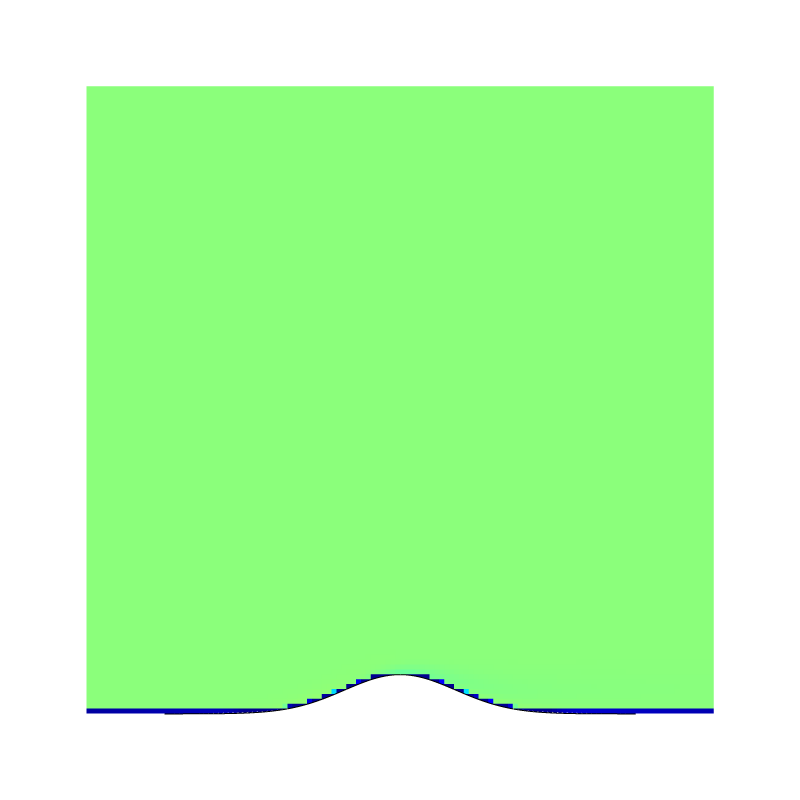sandbox/Antoonvh/embed-freeslip.c
Flow over an obstacle
On this page we embed a free slip mountain into a domain that is filled with an viscous fluid. The free-slip condition is not free of rotation along a curved boundary. Therefore, simple potential flow theory does not apply and we solve the equations for fluid motion.
#include "grid/multigrid.h"
#include "embed.h"
#include "navier-stokes/centered.h"
#include "view.h"
#define BVIEW 1
#include "particles.h"We set a free-slip boundary for the x and y components.
u.n[embed] = neumann (0);
u.t[embed] = neumann (0);
u.n[left] = dirichlet(min(t, 1.)*fm.x[]);
u.n[right] = neumann(0);
p[right] = dirichlet(0);
pf[right] = dirichlet(0);
face vector muc[];
int main(){
L0 = 8.;
for (N = 64; N <= 256; N *= 2){
init_grid(N);
run();
}
}
event properties(i++){
foreach_face()
muc.x[] = fm.x[] / 100.;
boundary((scalar*){muc});
}We use particles to check if the flow does not penetrate the embedded boundary.
event init (t = 0){
init_particles_2D_square_grid(5, 1, 0.52, 1);
mu = muc;
scalar phi[];
foreach_vertex()
phi[] = y - 0.5*exp(-sq(x - L0/2));
fractions(phi, cs, fs);
boundary(all);
output_ppm(cs, n = 512, file = "cs.png", min = 0, max = 1);
}To help the accurate evaluation of the viscous term, we enforce the time step according to a limit cell-Peclet number.
double PECLET = 0.5;
event stability(i++){
DT = 1.;
foreach_face(){
if (cs[] > 0.005 && fm.x[] > 0.005)
DT = min(DT, PECLET*sq(Delta)*cs[]/muc.x[]);
}
}We generate a movie displaying the flow via u_x and the tracers, these do not penetrate the boundary.
The particles follow the flow along the boundary
event mover(t += 0.05){
if (N == 128){
clear();
view(tx = -0.5, ty = -0.5);
draw_vof("cs", filled = -1, fc = {1, 1, 1});
squares("u.x", min = 0, max = 2);
scatter(loc);
draw_vof("cs", "fs");
save("movie.mp4");
}
}We also check if Bernoulli’s law is statisfied.
event stop(t = 10){
char fname[99];
sprintf(fname, "data%d", N);
FILE * fp = fopen(fname, "w");
foreach(){
if (y < L0/4 && fabs(x - L0/2.) < L0/4 && cm[] > 0.1)
fprintf(fp, "%g\t%g\n", p[], sq(u.x[]) + sq(u.y[]));
}set output 'plot.png'
set term pngcairo
set xlabel 'Modified pressure'
set ylabel 'K'
set size square
set grid
set key outside
plot 'data256' t 'N = 256', 'data128' t 'N = 128', 'data64' t 'N = 64'
There is an anti colleration between K and p … (script)
De deviation from the perfect anti correlation becomes less pronounced when a smaller value for the viscosity is used (not shown). Vorticity may diffuse into the domain along a curved free-slip boundary. As such, we check for the presence of vorticity via the entrophy.
scalar omega[];
vorticity(u, omega);
double Omega = 0;
foreach()
Omega += sq(omega[])*sq(Delta)*cm[];
static FILE * fpo = fopen ("omega", "w");
fprintf(fpo, "%d\t%g\n", N, Omega);set output 'plot2.png'
set term pngcairo
set logscale x 2
set xr [32:512]
set xlabel 'N'
set ylabel 'Omega'
set size square
set grid
set key off
plot 'omega' u 1:2 pt 5
There is a small resolution dependence on the diagnosed enstrophy (script)
We check were in the domain the vorticity exists.
if (N == 128){
clear();
view(tx = -0.5, ty = -0.5);
draw_vof("cs", filled = -1, fc = {1, 1, 1});
squares("omega");
draw_vof("cs", "fs");
save("vorticity.png");
}
}We can observe that indeed vorticty diffuses into the domain. Also note that the sign of the boundary curvature dictates the sign of the vorticity that diffuses into the domain.

A wake structure forms at the lee side of the free slip obstacle
A true eye-opener.
